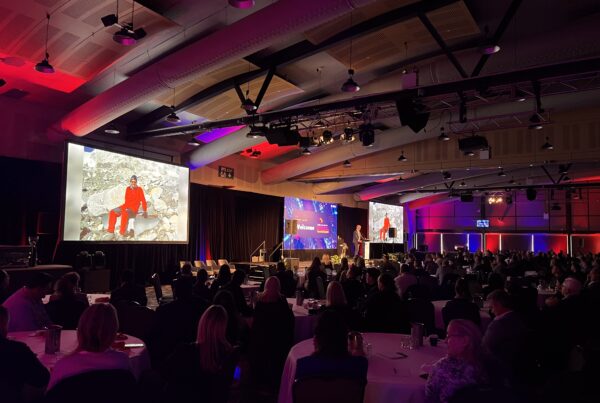Addressing future road funding and evolving crash safety
Last week’s Victorian Professional Development Forum in Melbourne revealed what is changing in our road network both how it’s paid for and the way vehicles on it are rated for safety.
Michele Huey from Transurban and James Goodwin from ANCAP (Australasian New Car Assessment Program) spoke to at a lunchtime session of fleet managers.

Michele Huey, Transurban. Courtesy Ian Porter, GoAuto
Huey revealed the infrastructure giant’s public road user study researching how people use our roads now and might in the future. “We are doing the groundwork on how we’ll pay for roads, bridges and infrastructure in future as government budgets tighten and expect more,” Huey said in her presentation. “We started the voluntary study 18 months ago to find out how real road users in Melbourne value and see as the needs for the future.”
“As cars on our roads become more fuel efficient, the excise tax used from every dollar to pay for roads and maintenance becomes increasingly difficult. This is driven by consumers demanding better economy and shifting to hybrids and electric vehicles which still cause wear and tear. So we have some challenges to meet and this is just one study into understanding how people use their vehicles now.”
“According to current models, fuel excise could come down about 45 per cent by 2050. So if you think about the amount of work being done on our roads, that’s a massive drop. We also have increasing issues of congestion.”
During the 18-month study, 30 per cent reported actively reported using public transport instead of driving their vehicle.
“Just over 1600 volunteer vehicle owners helped us explore what the alternative road funding sources might be. GPS devices were installed in their vehicles and information was collected about their travel patterns, time of day, distance etc. Undertanding this helps us understand what options there are.”
The study found our attitudes are relatively positive for the majority of participants, suggesting we’re open to the idea of evolving road systems but also fairly believe those who use, should pay.

The way we use, maintain and fund roads is likely to change
“Other options we’re looking at were caused by the consideration of vehicle age,” she continued. “An older car using more fuel will be paying more for the same road usage as a hybrid or EV. Putting our volunteers in various mock scenarios changed the way they used their vehicles. We found 60 per cent of our participants preferred a user-pays system compared to our current system. But before the study about 85 per cent were happy with the way it is now, without us explaining about the excise issue.”
Some participants found changing their patterns of vehicle use outside of the peak congestion times extremely difficult, further highlighting the issues of public transport availability in outer suburbs, work hours and flexibility.
Michele explained that the majority of attitudes changed as they got further into the study and provided Transurban with positive feedback.
James Goodwin explained the way the independent body, ANCAP (Australasian New Car Assessment Program), rates its benchmark five-star vehicles is changing.
“We’ve got to a point where there are too many five-star cars on our roads,” he stated, “Which is a good problem to have, but it means that vehicles rated longer than three years ago are now getting a bit smelly.”

James Goodwin, ANCAP. Courtesy Ian Porter, GoAuto
The former broadcast journalist detailed how fleet managers will be able to pick the most appropriate and safest vehicle for their fleets now and in the coming years.
“As responsible organisations, fleets play a huge role in road safety, both in your own fleets but also when they enter the used car market. The road toll is rising, five died on the road yesterday (November 9) alone, and in fact one in five cars is 15 years old and represent 40 per cent of the fatality crashes on our roads. So we need to improve the age of vehicles on our roads and your purchasing decisions today will influence for another 20 years.”
It’s a timely reminder given the holiday season is right around the corner and families, fleet managers and their staff take to the roads over summer.
“We change the goalposts to remain above regulation, namely the Australian Design Rules. We’re raising the bar for 2018 to align with EuroNCAP where it will not be possible to achieve a five-star ANCAP safety rating without autonomous emergency braking (AEB). But until then we need you, fleet managers, to use your consumer leverage and start asking for this active collision  avoidance now.”
avoidance now.”
“I wish we could skip 2017 to get AEB compulsory but until 2018, we’ve introduced date stamping which indicates the month and year the vehicle was crash tested. We strongly recommend no vehicle older than three years makes up any part of any fleet.”
The pole test will also change from a 90-degree angle to a more Australia-oriented 45 degrees to more accurately simulate running off the road into a tree or telegraph pole. Child and pedestrian protection, as well as crash avoidance, will be heavily weighted for 2018 ANCAP five-star ratings also. 
“Car manufacturers will introduce it more if you ask for it. Different brands have different names for collision avoidance like lane keeping systems and AEB, but we need to start preparing our vehicle fleet now.”
Both Michele and James’ presentations showed that attitudes on our roads are evolving and opening up to future ideas. A trend essential for fleet managers to be aware of as they prepare their fleets for what’s over the horizon.


















